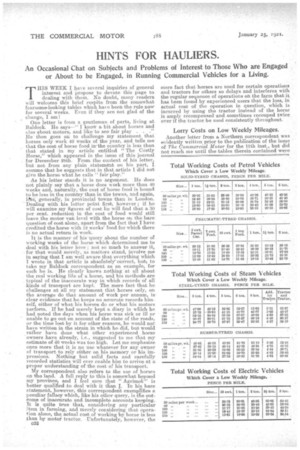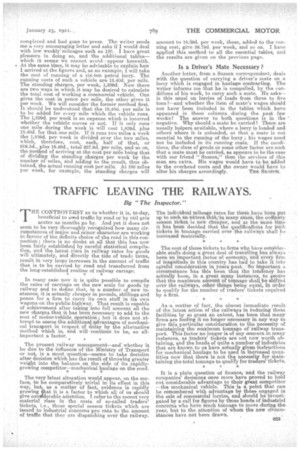HINTS FOR HAULIERS.
Page 22

Page 23

If you've noticed an error in this article please click here to report it so we can fix it.
An Occasional Chat on Subjects and Problems of Interest to Those Who are Engaged or About to be Engaged, in Running Commercial Vehicles for a Living.
THIS WEEK I have several inquiries of general interest and Propose to devote this page to dealing with them. No doubt, many readers will welcome this brief respite from the somewhat fearsome-looking tables which have been the rule now for several weeks. Even if they are not glad of the change, I aml One letter is from a gentleman of parts, living at Baldock. Ile says-" I know a bit about horses and also about motors, and like to see fair play . . ." He then goes on to challenge my statement that horses only work 40 weeks of the year, and tells me that the cost of horse food bethe country is less than that stated in my article entitled " The Costly Horse," which appeared in the issue of this journal for Deoember 28th. From the context of his letter, but not from any plain statement on his part, I assume that he suggests that. in that article I did not give the horse what he calls " fair play."
As his letter stands it is no argument. He does not plainly say that a horse does work more than 40 weeks and, naturally, the cost of horse food is bound to be less in the country than in the towns, and again, h'115s, generally, in provincial towns than in London. Dealing with his latter point first, however • if he will examine my figures of coat he will find that a 20 per cent. reduction in the cost of food would still leave the motor van level with the horse cni the bare question of cost alone' apart from the fact that I have credited the horse with 12 weeks' food for which there is no actual return in work.
it is the manner of his queryabout the number oI working weeks of the horse which determined me to deal with his letter here; not so much to answer it, • for that would merely, as matters stand, involve me in saying that I am well aware that everything which I wrote in that article is absolutely' correct, but) to take my Baldock correspondent as an example, for such he is. He clearly knows nothing at all about the real working life of a horse, and his methods are typical of the inaccurate way in which records of all kinds of transport are kept. The mere fact that he challenges at all my statement that horses only, on the average do that amount of work per annum is clear evidence that he keeps no accurate records himself, either of what his horses, do or what his motors perform. If he had merely kept a diary in which he had noted the days when his horse was sick or ill or unable to go out on account of the state of the roads, or the time lost by it for other reasons, he would not have written in the strain in which he did, but would . rather have done what other experiencedowners have already, i.e., suggested to me tat my estimate of 40 weeks was too high. Let me emphasize once more that it is no use whatever for any owner of transport to rely either on his memory or his impressions. Nothing but solid facts and carefully recorded statistics will ever enable him to arrive at a proper understanding of the cost of his transport. My correspondent also refers to the use of horses on the land. A full reply to this is somewhat beyond my 'province, and I feel sure that " Agriraoli4' is better qualified to deal with it than I. In his bare statement, however, this correspondent exemplifies a peculiar faIlaey which, like his other query, is the outcome of inaccurate and incomplete accounts keeping. It ie quite true that, considering any particular stem in fanning, and merely considering that operation alone, the actual cost of working by horse is leas than by motor tractor. Unfortunately, however, the
022
mere fact that horses are used for certain operations and tractors for others so delays and interferes with the regular sequence of operations on the farm that it has been found by experienced users that the loss, in actual cost of the operation in question, which, is incurred by using the tractor instead of the horse is amply recompensed and sometimes recouped twice over if the tractor be used consistently throughout.
Lorry Costs on Low Weekly Mileages.
Another letter from a Northern correspondent was evidently written prior to the publieation of the issue of The Commercial Motor for the 11th inst., but did not reach me until the tables therein contained were completed and had gone to press. The writer sends me a very encouraging letter and asks if I would deal with low weekly mileages 'such as las I have great Pleasure in doing so, and the additional tables— which it seems • we cannot avoid—appear herewith. • At the same time, it may be advisable to explain how I arrived at the figures and, as an example, I will take the cost of running of a six-bon petrol lorry. The running costs of such a vehicle are 18.40d. per mile. The standing charges, per week, 1,839d. Now there are two ways in which it may be desired to calculate the total cost of working a commercial vehicle. One gives the -cost in pence per mile, the other gives it per week. We Will consider the former method first. It should be understood that the 18.40d. per mile is to be added for every mile which the vehicle runs. The 1,839d. per week is an expense which is incurred whether the vehicle moves or not. If it only runs one mile during the week is will cost 1,839d. plus 18.40d. for that one mile. If it runs two miles a week the 1,839d. per week is divided .over the two miles, which, therefore, cost, each, half of that, or 919.5d., plus 18.40d., total 937.9d. per mile, and so on, the method of arriving at the cost per mile being that of dividing the standing charges per week by the number of miles, and adding to the result, thus obtained, the actual running cost per mile. At 100 miles per week, for example, the standing charges will amount to 18.49d. per week, these, added to the running cost, give 38.79d. per week, and so on. I have applied this method to all the essential tables and the results are given on the previous page.
Is a Driver's Mate Necessary ?
Another letter, from a Sussex correspondent, deals with the question of carrying a driver's mate on a lorry which is engaged in haulage contracting. The Writer informs me that he is compelled, by the coilditions of his work, to carry such a mate. He ask-is this usual on lorries of loads from three to five tons ?—and whether the iteiii of mate's wages shoold not have been included in the tables Which have appeared in these columns during the past few weeks? The answer to both questions is in the • • negative. Why should a mate be carried? There are usually helpers available, where a lorry is loaded and others where it is unloaded, so that a mate is not esential to the running of the lorry ; his wages need not be included in its running Costs. If the conditions, the class of goods or some other factor are such that a mate must be carried, as appears to be the case with our friend " Sussex," then the services of this man are extra. His wages would have to be added to the overhead costs and the owner would have to alter his charges accordingly. Tim Skotert.
































